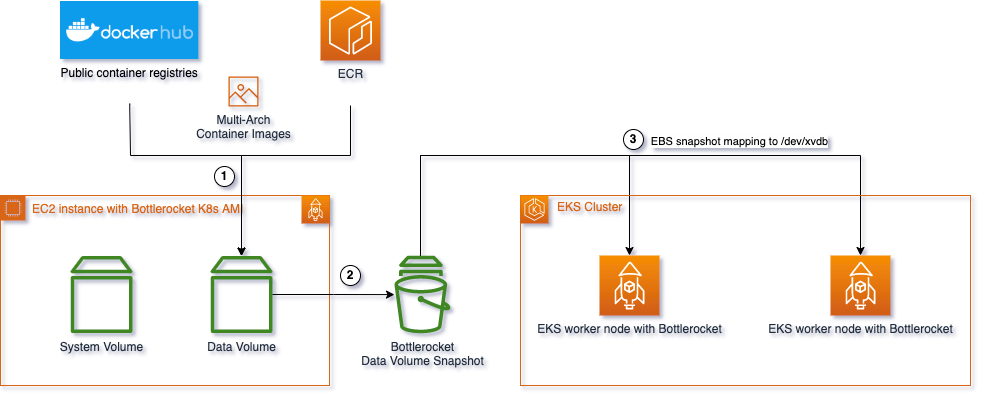The purpose of this sample is to reduce the boot time of containers with large images by caching the images in the data volume of Bottlerocket OS.
Data analytics and machine learning workloads often require large container images (usually measured by Gigabytes), which can take several minutes to pull and extract from Amazon ECR or other image registry. Reduce image pulling time is the key of improving efficiency of launching these containers.
Bottlerocket OS is a Linux-based open-source operating system built by AWS specifically for running containers. It has two volumes, an OS volume and a data volume, with the latter used for storing artifacts and container images. This sample will leverage the data volume to pull images and take snapshots for later usage.
To demonstrate the process of caching images in EBS snapshots and launching them in an EKS cluster, this sample will use Amazon EKS optimized Bottlerocket AMIs.
- Launch an EC2 instance with Bottlerocket for EKS AMI,
- Access to instance via Amazon System Manager
- Pull images to be cached in this EC2 using Amazon System Manager Run Command.
- Shut down the instance, build the EBS snapshot for the data volume.
- Terminate the instance.
-
Set up AWS CLI
-
Run the following command to clone this projects in your local environment.
git clone https://github.com/aws-samples/bottlerocket-images-cache/ cd bottlerocket-images-cache/ -
Run
snapshot.shto build the EBS snapshot. Replaceus-west-2to your region, and replacepublic.ecr.aws/eks-distro/kubernetes/pause:3.2to a comma seperated list of container images../snapshot.sh -r us-west-2 public.ecr.aws/eks-distro/kubernetes/pause:3.2
$ ./snapshot.sh -h
usage: ./snapshot.sh [options] <comma seperated container images>
Build EBS snapshot for Bottlerocket data volume with cached container images
Options:
-h,--help print this help
-r,--region Set AWS region to build the EBS snapshot, (default: use environment variable of AWS_DEFAULT_REGION, or IMDS if running on EC2)
-a,--ami Set SSM Parameter path for Bottlerocket ID, (default: /aws/service/bottlerocket/aws-k8s-1.27/x86_64/latest/image_id)
-i,--instance-type Set EC2 instance type to build this snapshot, (default: m5.large)
-R,--instance-role Name of existing IAM role for created EC2 instance, (default: Create on launching)
-q,--quiet Suppress all outputs and output generated snapshot ID only (default: false)
-e,--encrypt Encrypt the generated snapshot. (default: false)
-k,--kms-id Use a specific KMS Key Id to encrypt this snapshot, should use together with -e
-s,--snapshot-size Use a specific volume size (in GiB) for this snapshot. (default: 50)This script requires the following IAM policies:
"cloudformation:*",
"iam:GetInstanceProfile",
"iam:CreateInstanceProfile",
"iam:AddRoleToInstanceProfile",
"iam:DeleteInstanceProfile",
"iam:RemoveRoleFromInstanceProfile",
"iam:PassRole",
"ec2:Describe*",
"ec2:RunInstances",
"ec2:TerminateInstances",
"ec2:StopInstances",
"ec2:StartInstances",
"ec2:CreateVolume",
"ec2:AssociateIamInstanceProfile",
"ec2:ReplaceIamInstanceProfileAssociation",
"ec2:DisassociateIamInstanceProfile",
"ec2:CreateLaunchTemplate",
"ec2:CreateLaunchTemplateVersion",
"ec2:ModifyLaunchTemplate",
"ec2:DeleteLaunchTemplate",
"ec2:CreateSnapshot",
"ssm:CancelCommand",
"ssm:SendCommand",
"ssm:ListCommands",
"ssm:DescribeInstanceInformation",
"ssm:ListCommandInvocations",
"ssm:GetCommandInvocation",
"ssm:DescribeInstanceProperties",
"ssm:GetParameters"
If you choose to encrypt the snapshot with KMS using the --encrypt and/or --kms-id option, the following IAM policies is required:
"kms:RetireGrant",
"kms:CreateGrant",
"kms:ReEncrypt*",
"kms:GenerateDataKey*",
"kms:Encrypt",
"kms:DescribeKey",
"kms:Decrypt"
If you let the script create required IAM role for you, the following IAM policies is required:
"iam:AttachRolePolicy",
"iam:CreateRole"
"iam:DeleteRole"
"iam:DetachRolePolicy"
"iam:ListRoles"
"iam:ListRolePolicies"
"iam:ListPolicies"
There are 3 approaches to provision Amazon EC2 nodes for Amazon EKS cluster:
- EKS Managed Node Group
- Self managed nodes
- EC2 Fleet managed by Karpenter
You can use EBS snapshot created by the script with nodes created by all the approaches.
You can use a launch template to create volume from snapshot. When creating launch template, specify snapshot ID on volume with device name /dev/xvdb only. For detail, please refer to Customizing managed nodes with launch templates on Amazon EKS documentation.
You can specify snapshot ID in a Karpenter node template. You should also specify AMI used when provisioning node is BottleRocket. Add the content on EC2NodeClass (or AWSNodeTemplate on older release of Karpenter):
v1beta1 API:
apiVersion: karpenter.k8s.aws/v1beta1
kind: EC2NodeClass
metadata:
name: default
spec:
amiFamily: Bottlerocket # Ensure OS is BottleRocket
blockDeviceMappings:
- deviceName: /dev/xvdb
ebs:
volumeSize: 50Gi
volumeType: gp3
kmsKeyID: "arn:aws:kms:us-west-2:111122223333:key/1234abcd-12ab-34cd-56ef-1234567890ab" # Specify KMS ID if you use custom KMS key
snapshotID: snap-0123456789 # Specify your snapshot ID herev1alpha1 API:
apiVersion: karpenter.k8s.aws/v1alpha1
kind: AWSNodeTemplate
spec:
amiFamily: Bottlerocket # Ensure OS is BottleRocket
blockDeviceMappings:
- deviceName: /dev/xvdb # Make sure device name is /dev/xvdb
ebs:
volumeSize: 50Gi
volumeType: gp3
snapshotID: snap-0123456789 # Specify your snapshot ID here
kmsKeyID: "arn:aws:kms:us-west-2:111122223333:key/1234abcd-12ab-34cd-56ef-1234567890ab" # Specify KMS ID if you use custom KMS keySee CONTRIBUTING for more information.
This library is licensed under the MIT-0 License. See the LICENSE file.
